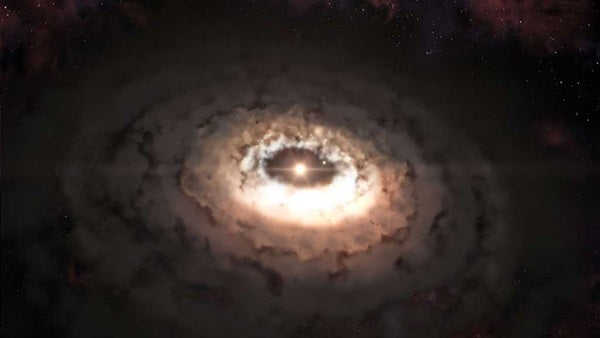Astronomers now know that planets around other stars are plentiful. But they do not fully understand how they form, and there are many aspects of the formation of comets, planets, and other rocky bodies that remain a mystery. However, new observations exploiting the power of ALMA are now answering one of the biggest questions: How do tiny grains of dust in the disk around a young star grow bigger and bigger to eventually become rubble and even boulders well beyond a meter in size?
Computer models suggest that dust grains grow when they collide and stick together. However, when these bigger grains collide again at high speed, they are often smashed to pieces and sent back to square one. Even when this does not happen, the models show that the larger grains would quickly move inward because of friction between the dust and gas, thus falling onto their parent star and leaving no chance that they could grow even further.
Somehow the dust needs a safe haven where the particles can continue growing until they are big enough to survive on their own. Such “dust traps” have been proposed, but there was no observational proof of their existence up to now.
Nienke van der Marel from Leiden Observatory in the Netherlands was using ALMA along with her co-workers to study the disk in a system called Oph-IRS 48. They found that the star was circled by a ring of gas with a central hole that was probably created by an unseen planet or companion star. Earlier observations using the European Southern Observatory’s (ESO) Very Large Telescope (VLT) had already shown that the small dust particles also formed a similar ring structure. But the new ALMA view of where the larger millimeter-sized dust particles were found was very different.
“At first, the shape of the dust in the image came as a complete surprise to us,” said van der Marel. “Instead of the ring we had expected to see, we found a very clear cashew-nut shape! We had to convince ourselves that this feature was real, but the strong signal and sharpness of the ALMA observations left no doubt about the structure. Then we realized what we had found.”
What they had discovered is a region where bigger dust grains are trapped and can grow much larger by colliding and sticking together. This is a dust trap — just what the theorists were looking for.
“It’s likely that we are looking at a kind of comet factory, as the conditions are right for the particles to grow from millimeter to comet size,” said van der Marel. “The dust is not likely to form full-sized planets at this distance from the star. But in the near future, ALMA will be able to observe dust traps closer to their parent stars, where the same mechanisms are at work. Such dust traps really would be the cradles for new-born planets.”
The dust trap forms as bigger dust particles move in the direction of regions of higher pressure. Computer modeling has shown that such a high-pressure region can originate from the motions of the gas at the edge of a gas hole — just like the one found in this disk.
“The combination of modeling work and high quality observations of ALMA makes this a unique project,” said Cornelis Dullemond from the Institute for Theoretical Astrophysics in Heidelberg, Germany. “Around the time that these observations were obtained, we were working on models predicting exactly these kinds of structures — a very lucky coincidence.”










